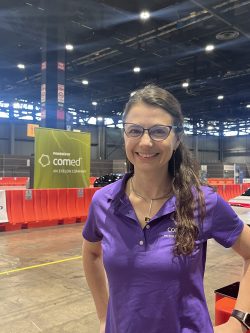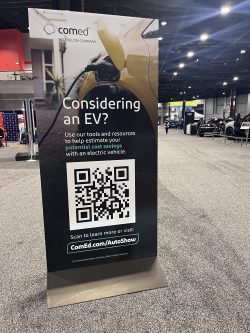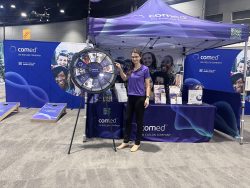ComEd goes the extra mile for zero emissions at the Chicago Auto Show
February 13, 2024
The air buzzes with anticipation to see 2024’s newest and most innovative vehicles at the Chicago Auto Show, the largest car show in the country. However, the next flashy rides and features weren’t the only things unveiled at this year’s auto show. To further advance Illinois’ clean energy goals of equitably curbing emissions and enhancing air quality, ComEd announced new EV rebate programs for the business and public sectors to help offset upfront costs and other barriers to expanding electric vehicles and the network of EV charging for the region. This was announced only a week after ComEd revealed its $5 million rebate program for residential customers to support the purchase and installation costs of installing Level 2 EV chargers in their homes.

Cristina Botero, senior manager of Beneficial Electrification
To learn more about how ComEd is supporting customers in driving toward the EVs of the future, we sat down with ComEd Senior Manager Cristina Botero, who leads ComEd’s all-new Beneficial Electrification programs. Cristina has a degree in Chemical and Bioengineering and a PhD in Mechanical Engineering from MIT. Growing up in Colombia and dedicating her career to discovering breakthroughs in clean energy, her background and expertise in the benefits of clean energy lend a unique perspective to this very timely endeavor as ComEd seeks to support customers in moving toward EVs.
What makes you so passionate about beneficial electrification?
There are many commodities we can live without for a day, but energy is not one of them. We know that transportation contributes about one-third of the greenhouse gas emissions in the U.S. today, so it’s important to address tailpipe emissions with cleaner modes of transportation. The good news is that northern Illinois is already ahead of the game when it comes to providing clean energy, which helps provide our customers confidence we can meet growing needs and will put us steps closer to the State’s clean energy goals.
What’s your favorite thing about your job?
I love being part of something innovative that will benefit our communities and the environment. I enjoy educating others about the benefits of going electric so that everyone can participate in this transition. It’s important to me that we make electrification accessible and affordable so that all communities can benefit from cleaner air.
How will the new EV rebate programs for the business and public sectors also benefit communities?
We know that businesses and municipalities depend a lot on transportation to get things done, driving their gasoline and diesel-powered vehicles through our neighborhoods every day. Lower-income communities have been historically hit hard by air pollution since many are located next to highways and near industry corridors. By supporting EV charging infrastructure and the conversion of fleets to EVs, we look to significantly reduce the amount of tailpipe emissions to improve the quality of the air that we all breathe.

More than half of the rebate funds are reserved for equity-eligible communities. Why was it important for ComEd to make that reservation?
To advance the widespread adoption of zero-emissions transportation, it’s critical that we ensure equitable access to EVs and the benefits that come with them. ComEd recognizes that barriers exist, especially for equity-eligible communities, those who have been most impacted by climate change and who may face the biggest barriers to transitioning toward EVs. By reserving more than half of our funds for these communities and offering them higher rebates, we are keeping equity front of mind to ensure that all our customers can participate in the clean energy transition.
Why is EV charging such a big focus of this new rebate plan?
With 80,000 electric vehicles currently driving in northern Illinois and more to come, we are on a mission to eliminate barriers to EV ownership, of which range anxiety is up top, by ensuring an expanded charging network to keep up with demand. We are doing this through incentives that will expand both private and public charging networks and empower customers to comfortably make the switch to EV whether it’s for their business, their personal use, or for local governments that want to participate in the energy transition.
If an individual, business, or township is not ready to make the switch this year, what can they do?
The great thing about our beneficial electrification plan is that it’s a multi-year plan. More rebates for residential, business and public sector customers will be available next year, and ComEd will continue to be a steady partner to customers as they determine if moving to an EV is right for them, and as they make arrangements to go electric at home or at work. In the meantime, we suggest learning more about the benefits of adopting EVs and current rebate options.
 What resources are available to help customers better understand their options when making the switch to EVs?
What resources are available to help customers better understand their options when making the switch to EVs?
ComEd offers multiple free resources to support our customers through their electrification journey. To name a few, we have residential and commercial EV Toolkits, a resource that calculates fuel-cost savings of switching to an EV, describes everything that it entails, and provides an overview of available incentives. The application to the new business and public sector rebates launches February 15. To help support EV adoption at scale, we offer Fleet Electrification Assessments free of charge, and we offer an EV load capacity map that provides an estimate to our customers of what areas have more or less load capacity today to install EV fleet charging stations without the need for upgrades.
All this information and more is available at ComEd’s booth at the Chicago Auto Show until the last day on February 19, and online at www.comed.com/clean.
